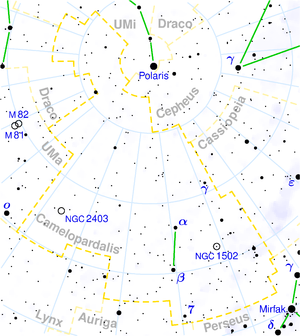Giraffe (constellation)
|
Giraffe constellation |
|
|---|---|
| Latin name | Camelopardalis |
| Latin genitive | Camelopardalis |
| Abbreviation | Cam |
| Right ascension | 03 h 15 m 36 s to 14 h 27 m 08 s |
| declination | + 52 ° 39 ′ 56 ″ to + 86 ° 05 ′ 51 ″ |
| surface | 756.828 deg² rank 18 |
| Completely visible | 90 ° N to 1.5 ° S |
| Observation time for Central Europe | All year round |
| Number of stars brighter than 3 mag | 0 |
| Brightest star (size) | β Cam (4.03) |
| Meteor streams | |
|
Neighboring constellations ( clockwise from north ) |
|
| swell | IAU , |
 From the star atlas by Johann Elert Bode from 1782 |
|
The giraffe or the camelopard ( Latin Camelopardalis ) is a constellation of the northern sky .
description
The giraffe is a vast but very inconspicuous constellation and can be observed all year round.
Between the prominent constellations Great Bear and Kassiopeia and the bright stars Polaris (in Little Bear ) and Capella (in Fuhrmann ) there is a large area that does not contain any conspicuous stars. The giraffe, which is composed only of stars of the fourth, fifth or sixth magnitude , extends in this area . The brightest star, β Camelopardalis, has an apparent magnitude of 4.0 mag.
history
In ancient times, the stars of the giraffe were not assigned to any constellation. It was not until the Dutch cartographer Petrus Plancius introduced Camelopardalis in 1612, apparently to fill the supposed “gap” in the sky.
The German astronomer Jacob Bartsch , a son-in-law of Johannes Kepler , adopted the constellation in his Planisphaerium Stellaris , published in 1624 . However, he saw it as a mount mentioned in the Bible , on which Rebekah rode to her wedding. Apparently, Bartsch believed it was a camel .
Celestial objects
Stars
| B. | F. | Names, other names | Apparent brightness likes | Absolute brightness Mag | Lj | Spectral class |
|---|---|---|---|---|---|---|
| β | 10 | 4.03 | −3.4 | 1000 | G0 Ib | |
| α | 9 | 4.26 | −7 | 7000 | O9.5 Ia | |
| 7th | 4.43 | −0.9 | 380 | A1 V | ||
| BE | 4.47 | −3 | 1000 | M1 III | ||
| γ | 4.59 | −0.5 | 340 | |||
| CE | 4.60 | −5 | 2500 | A0 Ia | ||
| M. | 4.55 | 0.76 | 187 | K4 III | ||
| BK | 4.74 | −2 | 800 | B2.5 V | ||
| HR 2209 | 4.76 | 1.1 | 176 | A0 V | ||
| HR 1129 | 4.78 | −2 | 800 | A3 V | ||
| VZ | 4.92 | −0.9 | 470 | M4 IIIa | ||
| 3 | 5.05 | |||||
| 11 | 5.08 | |||||
| 43 | 5.12 | |||||
| 42 | 5.14 |
Alpha Camelopardalis is the third brightest star in the giraffe with an apparent magnitude of 4.26 mag. Measurements from the Hipparcos satellite showed a distance of 7,000 light years. Since the parallax measurements for distant stars are associated with great inaccuracies, the distance could also be only 4000 light years. The star is a massive bluish-white supergiant .
Double stars
| system | Apparent brightness likes | distance |
|---|---|---|
| β | 4.03 / 7.4 | 81 " |
| 11 | 5.1 / 6.3 | 180 " |
Beta Camelopardalis is a binary star system 1500 light years away. It consists of a yellowish main star of the spectral class G0 and a white luminous companion star of the spectral class A5. The main star has 7 times the mass and 32 times the luminosity of our sun .
The system 11 Camelopardalis is 600 light years away. It consists of a bluish-white star of the spectral class B3 and an orange star of the spectral class K0.
Both systems can be resolved into single stars with a small telescope .
Variable stars
| star | Apparent brightness likes | period | Type |
|---|---|---|---|
| U | Semi-regular variable star | ||
| Z | 10.0 to 14.5 | irregular | Dwarf Nova |
| BE | Slowly irregularly changing star | ||
| BV | Be star | ||
| CS | Short-term variable |
NGC objects
| NGC | other | m | Type | Surname |
|---|---|---|---|---|
| 1502 | 6.0 | Open star cluster | ||
| 2403 | 8.5 | Galaxy | ||
| IC 342 | 8.4 | Galaxy |
NGC 1502 is an open star cluster 6800 light years away that was discovered by Wilhelm Herschel . A loose cluster of stars can be seen in larger binoculars . A multitude of stars can be seen in the telescope.
NGC 2403 is a galaxy about 10 million light years away. It can already be seen in binoculars as a misty spot. Hints of spiral arms can be seen in a larger telescope.
See also
Web links
- Cross reference for 41 stars in the constellation
- The constellation Giraffe. Astronomie.de
Individual evidence
- ↑ Duden: Camelopard

